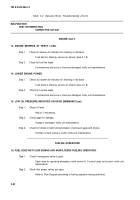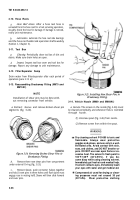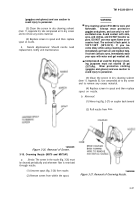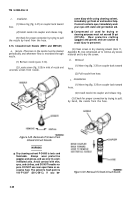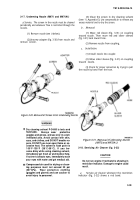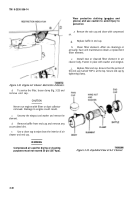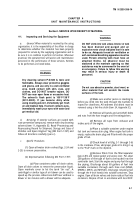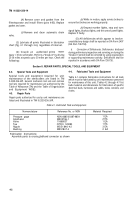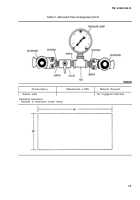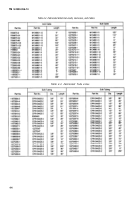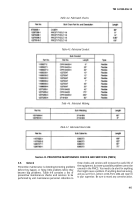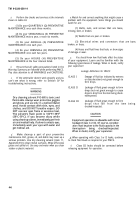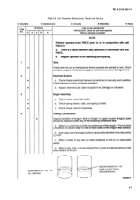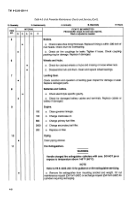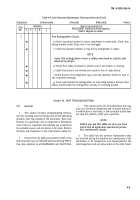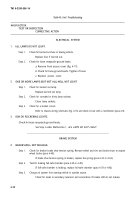TM-9-2330-356-14
SEMITRAILER, TANK: 5000 GALLON, BULK HAUL, SELF LOAD/UNLOAD M967 AND M967A1; SEMITRAILER, TANK: 5000 GALLON, FUEL DISPENSING, AUTOMOTIVE M969 AND M969A1; SEMITRAILER, TANK: 5000 GALLON, FUEL DISPENSING, UNDER/OVERWING AIRCRAFT M970 AND M970A1
TECHNICAL MANUAL; OPERATOR’S, UNIT, DIRECT SUPPORT, AND GENERAL SUPPORT MAINTENANCE MANUAL
OCTOBER 1990
TM-9-2330-356-14 - Page 137 of 528
TM 9-2330-356-14
CHAPTER 4
UNIT MAINTENANCE INSTRUCTIONS
Section I. SERVICE UPON RECEIPT OF MATERIAL
4-1.
Inspecting and Servicing the Equipment
a.
General.
When material is received by the using
organization, it is the responsibility of the officer in charge
to determine whether the material has been properly
prepared for service by the supplying organization and to
be sure it is in condition to perform its function. Whenever
practical, the operator/crew will assist unit maintenance
personnel in the performance of these services. Semites
to be performed are listed below.
WARNING
Dry cleaning solvent P-D-680 Is toxic and
flammable. Always wear protective goggles
and gloves, and use only in a well-ventilated
area. Avoid contact with skin, eyes, and
clothes, and DO NOT breathe vapors. DO
NOT use near open flame or excessive heat.
The solvent’s flash point is 100°F-138°F
(38°C-590C). If you become dizzy while
using cleaning solvent, immediately get fresh
air and medical help. If solvent contacts eyes,
immediately wash your eyes with water and
get medical aid.
b.
Servicing.
If exterior surfaces are coated with
rust-preventive compound, remove with dry cleaning
solvent (item 11, Appendix E). Read “Processing and
Reprocessing Record for Shipment, Storage and Issue of
Vehicles and Spare Engines” tag (DD Form 1397) and
follow all directions carefully (para c).
c.
Specific Procedures.
(1) Open all water drain valves (figs. 2-24 and
2-25) to remove preservative.
(2) Depreservation following DD Form 1397:
(a)
Place containers under all drain valves.
Open all drain valves to remove the preservative liquid.
Open manhole cover to let the tank “air out”. A
centrifugal or similar type of air blower can be used to
speed up the process. About one-half hour without a
blower or ten minutes with a blower will be adequate.
WARNING
DO NOT climb into tank unless Interior of tank
has been drained and purged and an
explosive meter check indicates that It is safe
to do so. Adequate forced air ventilation or
self-contained breathing apparatus must be
used. Person entering tank must have an
attached lifeline. An observer must be
stationed at the manhole opening so that
assistance may be summoned in the event of
an emergency. Failure to follow this warning
may result in serious injury or death to
personnel.
CAUTION
Do not use abrasive powder, steel wool, or
other material that will scratch the inside
surfaces of the tank.
(b)
Make sure another person is standing by
before you climb into the tank through the manhole to
inspect for cleanliness. All sediment and debris must be
removed using a lint-free cloth (item 24, Appendix E).
(c) Remove all bands and anti-theft bolts
and nuts from the hose troughs and fire extinguishers.
(d)
Remove all tape from exhaust and
intake ports of the engine.
(e)
Place a suitable container under engine
fuel tank and remove drain plug. When engine fuel tank is
empty, replace the drain plug and fll tank with the proper
grade of fuel.
(f)
Check level of oil (fig. 3-1 through 3-6)
in the crankcase. If low, add proper grade oil to bring it up
to the “Full” mark on the dipstick.
(g)
Remove filters from the filter/separator
(para 4-83) and replace gasket and access cover. Put about
200 gallons of the type of fuel to be hauled into the
semitrailer tank. Start the engine and pump fuel through
the piping. Discharge about 60 gallons of fuel into
suitable containers through each hose reel (M969,
M969A1, M970, and M970A1). Discharge remaining fuel
through the 4-inch hose(s) into suitable containers. Stop
engine. Open all drain valves and drain residual fuel into
containers. Dispose of fuel in accordance with local SOP.
4-1
Back to Top


